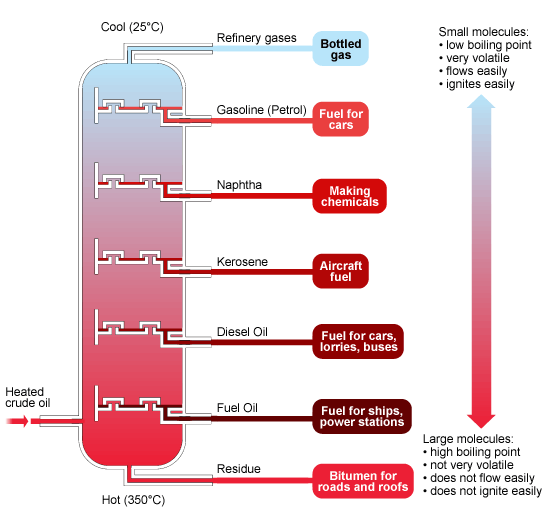Heavy Fuel Oil Trading
Heavy fuel oils (HFO) are mainly used as marine fuel, and HFO is the most widely used marine fuel at this time.Heavy Fuel Oil Applications
The generic term heavy fuel oil (HFO) describes fuels used to generate motion and/or fuels to generate heat that have a particularly high viscosity and density. In the MARPOL Marine Convention of 1973, heavy fuel oil is defined either by a density of greater than 900 kg/m³ at 15°C or a kinematic viscosity of more than 180 mm²/s at 50°C. Heavy fuel oils have large percentages of heavy molecules such as long-chain hydrocarbons and aromatics with long-branched side chains. They are black in color. Heavy fuel oils are mainly used as marine fuel, and HFO is the most widely used marine fuel at this time; virtually all medium and low-speed marine diesel engines are designed for heavy fuel oil. But older steam locomotives and oil-fired power plants also generate energy from heavy fuel oils. Heavy fuel oil is a residual fuel incurred during the distillation of crude oil. The quality of the residual fuel depends on the quality of the crude oil used in the refinery. To achieve various specifications and quality levels, these residual fuels are blended with lighter fuels such as marine gasoil or marine diesel oil. The resulting blends are also referred to as intermediate fuel oils (IFO) or marine diesel oil. They are classified and named according to their viscosity. The most commonly used types are IFO 180 and IFO 380, with viscosities of 180 mm²/s and 380 mm²/s, respectively. If there is a predominance of heavy fuel oil in a blend, it is assigned to the heavy fuel oil category. As these are blends of heavy fuel oil and lighter fuels, they can also be referred to as a heavy marine diesel oil.
A key differentiator of heavy fuel oils is their sulfur content. According to ISO 8217, their maximum sulfur content must not exceed 3.5%. The following main classes with regard to the sulfur content can be distinguished:
| Marine Fuel | Max. Sulfur Content |
|---|---|
| High sulfur fuel oil (HSFO) | 3.5% |
| Low sulfur fuel oil (LSFO) | 1.0% |
| Ultra low sulfur fuel oil (ULSFO) | 0.1% |
High-sulfur fuel oil (HSFO)
The alternative to using marine fuels with such low sulfur content in ECAs is the use of scrubbers. This technology involves injecting water into the exhaust stream to reduce sulfur and other emissions. However, refitting a ship with this technology costs several million euros and means that the ship is docked for a period of time, which leads to a loss in revenue and income for the shipowners. On the other hand, a scrubber allows higher-sulfur marine fuels to be used. In this context, such heavy fuel oils are designated as high-sulfur fuel oils (HSFO), which have a maximum sulfur content of 3.5% as permitted under ISO 8217.
Low sulfur fuel oil (LSFO)
Heavy fuel oils are referred to as low sulfur fuel oil (LSFO) if their sulfur content is below 1%. Usually these are marine fuel types IFO 180 or IFO 380, which have been desulfurized. Until the end of 2014, ships could still travel through Emission Control Areas (ECAs) with this type of marine fuel.
Ultra-low sulfur fuel oil (ULSFO)
Since January 1, 2015, in accordance with Annex VI of the MARPOL Conventions, ship emissions must contain no more than 0.1% sulfur in such protected areas (ECAs). Due to these tightened restrictions, LSFOs no longer play an appreciable role in these areas and have been virtually replaced with the ultra-low sulfur fuel oil (ULSFO) marine fuel, which complies with those limits. Theoretically, heavily desulfurized IFO fuels could also be used here, but in practice the desulfurization of such heavy fuel oils is too expensive to make economic sense. For this reason, today the term ultra-low sulfur fuel oil usually refers not to desulfurized heavy fuel oils, but to marine gasoil, which is already low.
Other Oil Types
EN590
EN590 is the current standard for all automotive diesel fuel sold in the European Union member states. It is published by the European Committee for Standardization and it describes the physical properties of the fuel.
Light Cycle Oil
Light Cycle Oil (LCO) is the diesel boiling range material, which is produced in addition to gas and petrol in the Fluid Catalytic Cracking Unit (FCCU). LCO is treated in the diesel hydrotreater (DHT) unit to produce low sulphur
Napha
Naphtha is produced primarily from the distillation of crude oil and is the intermediate product between the light gases and the heavier kerosene. It can also be a component of natural gas condensates.
Petoke
As refineries worldwide seek to operate more efficiently and extract more gasoline and other high value fuels from each barrel of crude oil, a solid carbon material known as petcoke is produced.
Light Liquid Paraffin
LLP, Kerosene, or lamp oil is a combustible hydrocarbon liquid which is derived from petroleum. It is widely used as a fuel in aviation as well as households.

